






According to data from the National Bureau of Statistics (NBS), in September 2025, the ex-factory prices of industrial producers nationwide decreased by 2.3% YoY, with the decline narrowing by 0.6 percentage points compared to the previous month, and remained flat MoM. The purchasing prices of industrial producers decreased by 3.1% YoY, with the decline narrowing by 0.9 percentage points from the previous month, and increased by 0.1% MoM. On average from January to September, the ex-factory prices of industrial producers decreased by 2.8% compared to the same period last year, while the purchasing prices decreased by 3.2%.
YoY Decline in Ex-Factory Prices of Industrial Producers Continued to Narrow in September 2025
In September 2025, the ex-factory prices of industrial producers nationwide decreased by 2.3% YoY, with the decline narrowing by 0.6 percentage points compared to the previous month, and remained flat MoM. The purchasing prices of industrial producers decreased by 3.1% YoY, with the decline narrowing by 0.9 percentage points from the previous month, and increased by 0.1% MoM. On average from January to September, the ex-factory prices of industrial producers decreased by 2.8% compared to the same period last year, while the purchasing prices decreased by 3.2%.
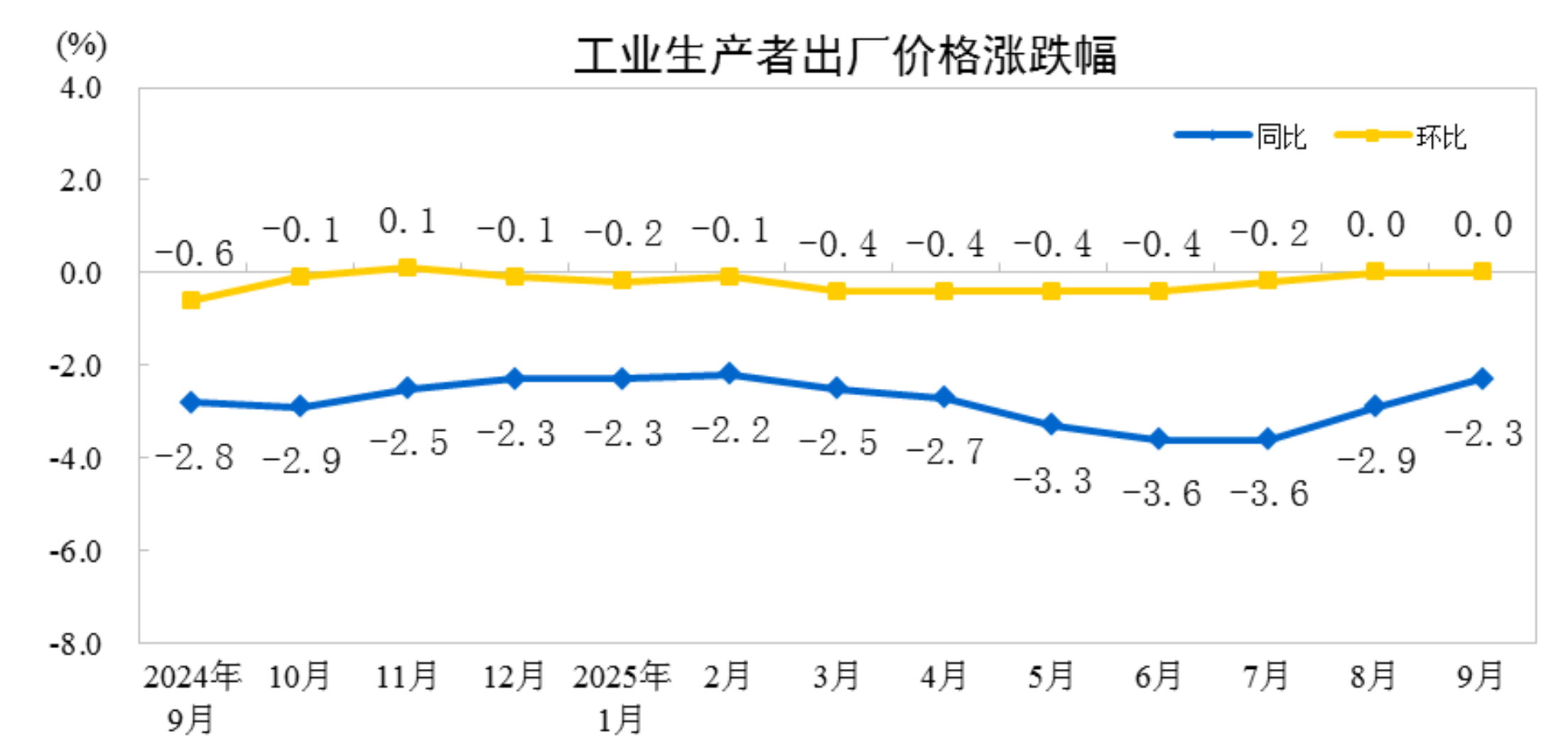
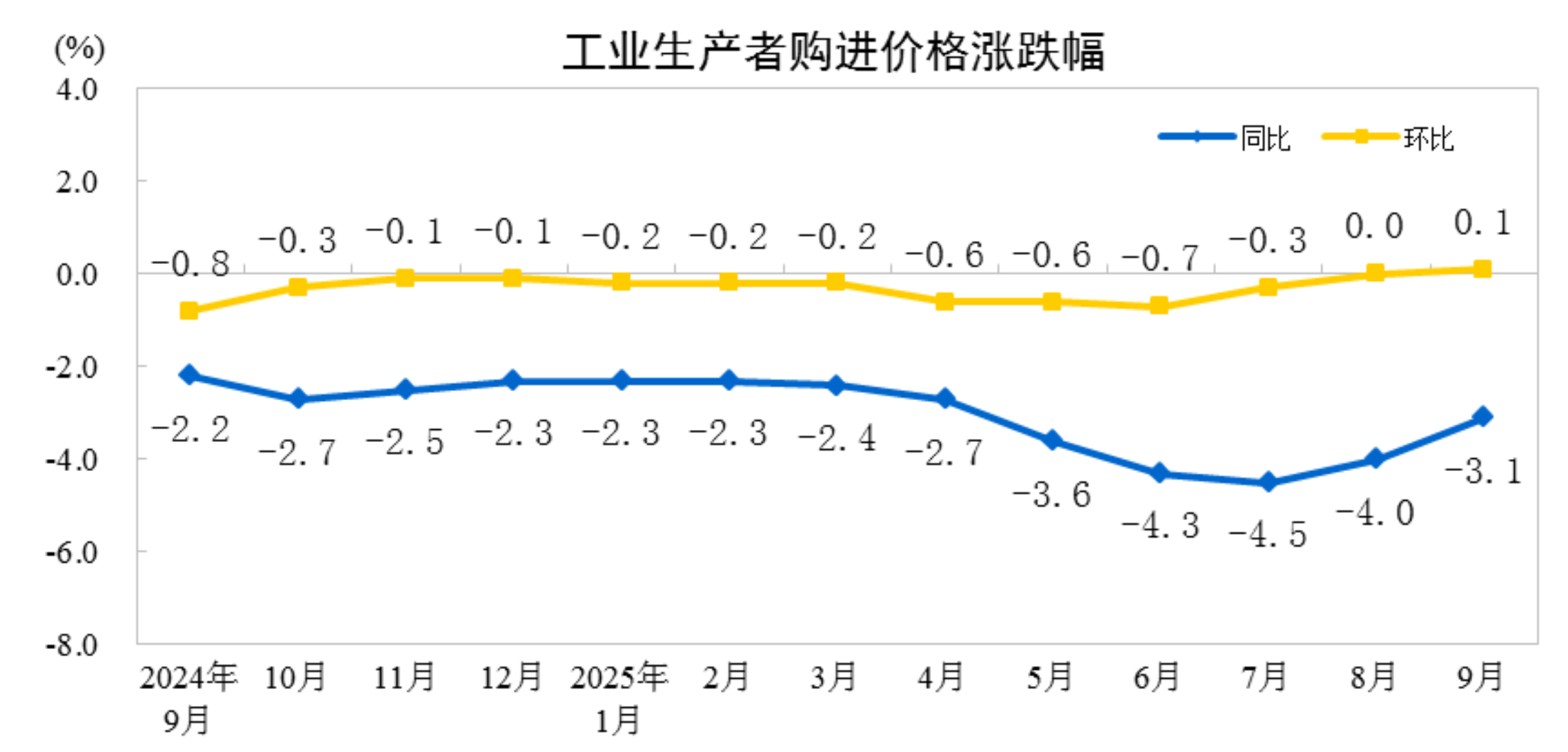
I. YoY Changes in Industrial Producer Prices
In September, within the ex-factory prices of industrial producers, the price of means of production decreased by 2.4%, dragging down the overall ex-factory price level by approximately 1.81 percentage points. Among these, the price of mining and quarrying industry decreased by 9.0%, the price of raw material industry decreased by 2.9%, and the price of processing industry decreased by 1.7%. The price of means of livelihood decreased by 1.7%, dragging down the overall ex-factory price level by approximately 0.45 percentage points. Among these, the price of food decreased by 1.7%, the price of clothing decreased by 0.3%, the price of general consumer goods increased by 0.7%, and the price of durable consumer goods decreased by 3.9%.
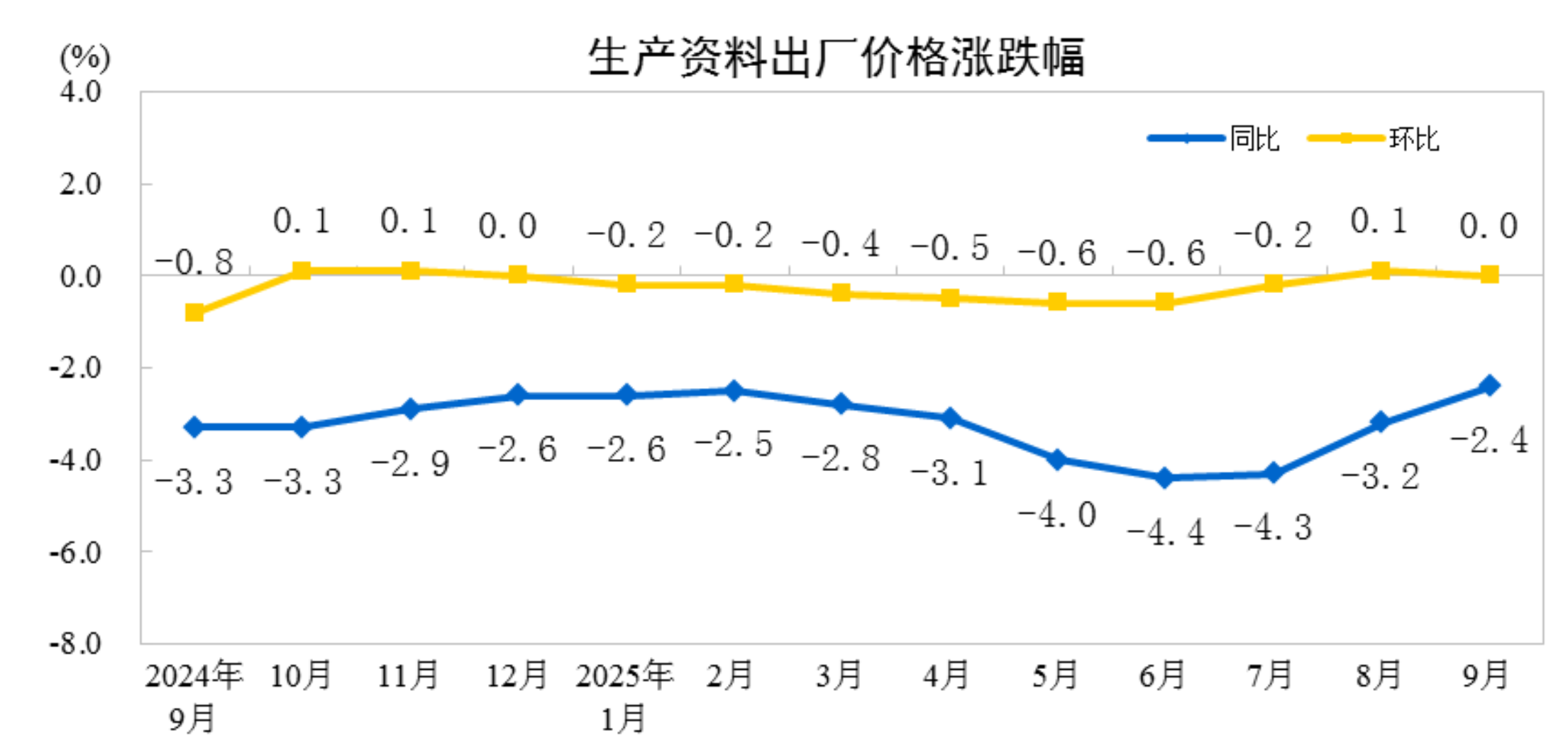
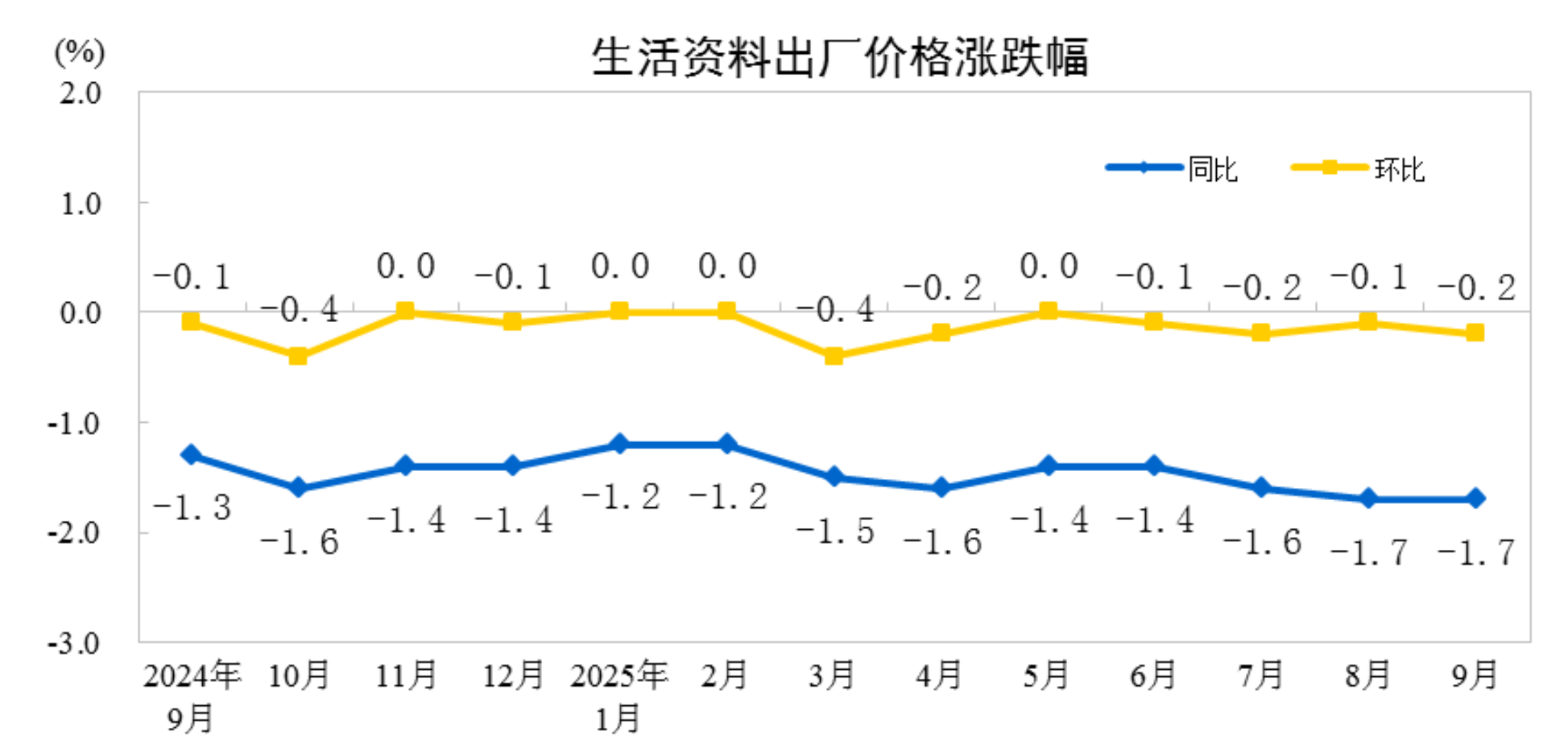
Within the purchasing prices of industrial producers, the price of fuel and power decreased by 8.1%, the price of chemical raw materials decreased by 5.5%, the price of agricultural and sideline products decreased by 5.4%, the price of building materials and non-metals decreased by 4.5%, the price of ferrous metals decreased by 2.9%, and the price of textile raw materials decreased by 1.7%; the price of non-ferrous metals and wires increased by 6.6%.
II. MoM Changes in Industrial Producer Prices
In September, within the ex-factory prices of industrial producers, the price of means of production remained flat. Among these, the price of mining and quarrying industry increased by 1.2%, the price of raw material industry remained flat, and the price of processing industry decreased by 0.1%. The price of means of livelihood decreased by 0.2%, dragging down the overall ex-factory price level by approximately 0.04 percentage points. Among these, the price of food decreased by 0.1%, the price of clothing remained flat, the price of general consumer goods increased by 0.2%, and the price of durable consumer goods decreased by 0.4%.
Among industrial producer purchase prices, non-ferrous metal materials and wire categories rose 1.2%, fuel and power categories rose 0.5%, and ferrous metal materials categories rose 0.4%; building materials and non-metallic categories fell 0.6%, chemical raw material categories fell 0.4%, agricultural and sideline product categories fell 0.2%, and textile raw material categories fell 0.1%.
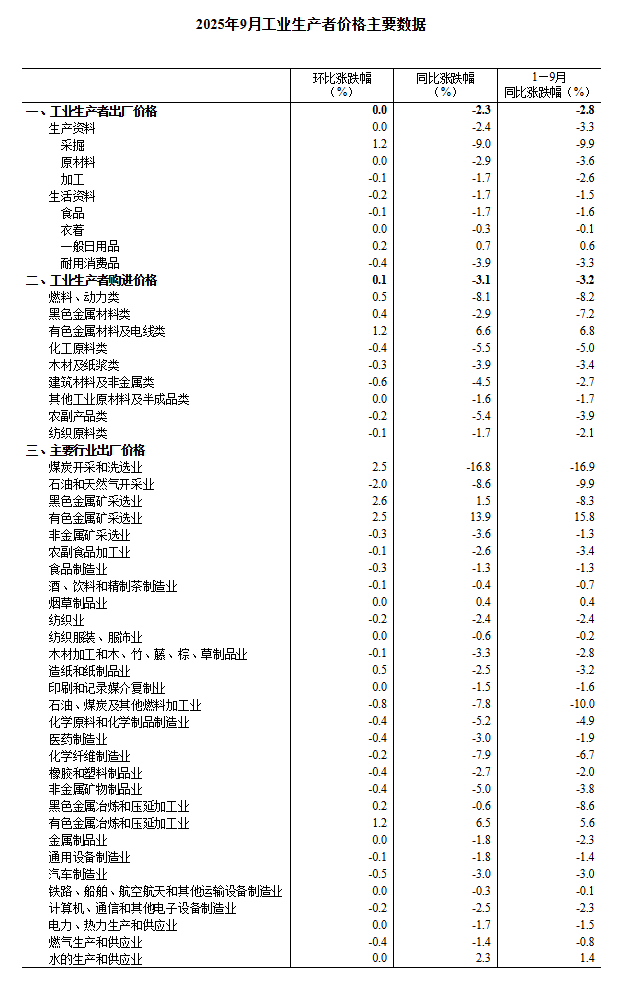
Core CPI YoY Increase Continued to Expand in September 2025
PPI YoY Decline Continued to Narrow
—Dong Lijuan, Chief Statistician of the Urban Department of the National Bureau of Statistics (NBS), Interprets CPI and PPI Data for September 2025
In September, the consumer market operated generally stable, with the Consumer Price Index (CPI) up 0.1% MoM and down 0.3% YoY. Core CPI, which excludes food and energy prices, rose 1.0% YoY, marking the fifth consecutive month of increase in the growth rate. With the in-depth advancement of building a unified national market and continuous optimization of market competition order, the Industrial Producer Ex-factory Price Index (PPI) remained flat MoM; it fell 2.3% YoY, with the decline narrowing by 0.6 percentage points from the previous month.
I. CPI Turned from Flat to Up MoM, Core CPI YoY Increase Rebounded to 1%
CPI rebounded MoM, turning from flat in the previous month to an increase of 0.1%. Among these, food prices rose 0.7% MoM, with the increase expanding by 0.2 percentage points from the previous month, contributing about 0.13 percentage points to the MoM rise in CPI. Within food, prices of fresh vegetables, eggs, fresh fruit, mutton, and beef all showed seasonal increases, ranging between 0.9% and 6.1%; pork and aquatic products were in ample supply, with prices falling 0.7% and 1.8%, respectively. Industrial consumer goods excluding energy rose 0.5%, contributing about 0.12 percentage points to the MoM CPI increase. Among these, domestic gold jewelry prices rose 6.5% influenced by rising international gold prices; with the autumn clothing season and new arrivals, clothing prices rose 0.8%; prices of recreational durable consumer goods, household appliances, and daily household articles rose 0.9%, 0.6%, and 0.6%, respectively. Affected by declines in service and energy prices, the MoM increase in CPI was slightly lower than the seasonal average. Service prices fell 0.3%, contributing about 0.12 percentage points to the MoM decline in CPI. Among these, due to the end of the summer holiday and the Mid-Autumn Festival falling in a different month compared to previous years, prices for air tickets, hotel accommodation, and travel fell 13.8%, 7.4%, and 6.1%, respectively, collectively contributing about 0.17 percentage points to the MoM decline in CPI. Energy prices fell 0.8%, among which domestic gasoline prices fell 1.7% influenced by changes in international oil prices.
CPI fell 0.3% YoY, with the decline narrowing by 0.1 percentage points from the previous month. The CPI decline was mainly due to carryover effects. Of the 0.3% YoY change in CPI this month, the carryover effect contributed approximately -0.8 percentage points, while new price changes from this year contributed about 0.5 percentage points. By category, food and energy prices declined. Food prices fell 4.4%, with the decline widening 0.1 percentage points from the previous month, dragging down CPI by about 0.83 percentage points YoY, making it the primary factor behind the CPI decline. Within food, prices of pork, fresh vegetables, eggs, and fresh fruit dropped 17.0%, 13.7%, 13.5%, and 4.2%, respectively, collectively pulling CPI down by about 0.78 percentage points YoY. Beef and mutton prices rose 4.6% and 0.8%, respectively, with mutton prices increasing for the first time after 44 consecutive months of decline. Energy prices fell 2.7%, dragging CPI down by about 0.2 percentage points YoY. Core CPI, which excludes food and energy, rose 1.0% YoY, marking the fifth consecutive month of expanding growth and the first time in nearly 19 months that the growth rate returned to 1%. Among these, prices of industrial consumer goods excluding energy increased 1.8%, with the growth rate expanding for the fifth consecutive month. Within industrial consumer goods, prices of gold and platinum jewelry rose 42.1% and 33.6%, respectively, while prices of household appliances, daily household goods, and communication tools increased 5.5%, 3.2%, and 1.5%, respectively, all with expanded growth rates. Service prices rose 0.6%, remaining relatively stable, with medical services and household services prices up 1.9% and 1.6%, respectively, while hotel accommodation and air ticket prices fell 1.5% and 1.7%, respectively.
II. PPI Was Flat MoM, with YoY Decline Narrowing Further
PPI remained flat MoM for the second consecutive month. Key characteristics of PPI trends this month: First, improved supply-demand structure drove noticeable price stabilization in some industries. Coal processing prices rose 3.8% MoM, coal mining and washing prices increased 2.5%, and ferrous metals smelting and pressing prices rose 0.2%, all up for two consecutive months. PV equipment and components manufacturing prices shifted from a 0.2% decline last month to a 0.8% increase. Non-metallic mineral products and lithium-ion battery manufacturing prices fell 0.4% and 0.2%, respectively, with declines narrowing 0.6 and 0.3 percentage points from the previous month. Second, imported factors led to MoM declines in domestic petroleum-related industry prices. Lower international oil prices drove down domestic petroleum-related industry prices MoM. Among these, petroleum extraction prices fell 2.7%, refined petroleum product manufacturing prices dropped 1.5%, organic raw chemical material manufacturing prices declined 0.6%, and chemical fiber manufacturing prices decreased 0.2%.
The PPI fell by 2.3% YoY, with the decline narrowing by 0.6 percentage points from the previous month. In addition to the impact of a lower comparison base from the same period last year, the effects of China's macro policies continued to manifest, with prices in some industries showing positive changes. First, the deepening advancement of the national unified market contributed to a narrowing YoY decline in prices for related industries. Capacity management in certain industries showed results, market competition order continued to improve, and the YoY price decline narrowed. The price declines for coal processing, smelting and pressing of ferrous metals, coal mining and washing, PV equipment and components manufacturing, battery manufacturing, and non-metallic mineral products narrowed by 8.3, 3.4, 3.0, 2.4, 0.5, and 0.4 percentage points, respectively, from the previous month. These six industries reduced the downward drag on the YoY PPI by approximately 0.34 percentage points compared to the previous month. Second, industrial structure upgrading and the release of consumption potential drove YoY price increases in related industries. The accelerated construction of a modern industrial system, along with positive trends in the high-end, intelligent, and green development of manufacturing, steadily expanded market demand. Aircraft manufacturing prices rose by 1.4% YoY, electronic specialty materials manufacturing prices increased by 1.2%, waste resource comprehensive utilization industry prices climbed by 0.9%, and wearable smart device manufacturing prices edged up by 0.1%. The effects of policies to boost consumption continued to emerge, with the release of quality and upgraded consumption demand. Prices for arts, crafts, and ceremonial product manufacturing rose by 14.7% YoY, sports ball manufacturing prices increased by 4.0%, and nutritional food manufacturing prices grew by 1.8%.
For queries, please contact Lemon Zhao at lemonzhao@smm.cn
For more information on how to access our research reports, please email service.en@smm.cn